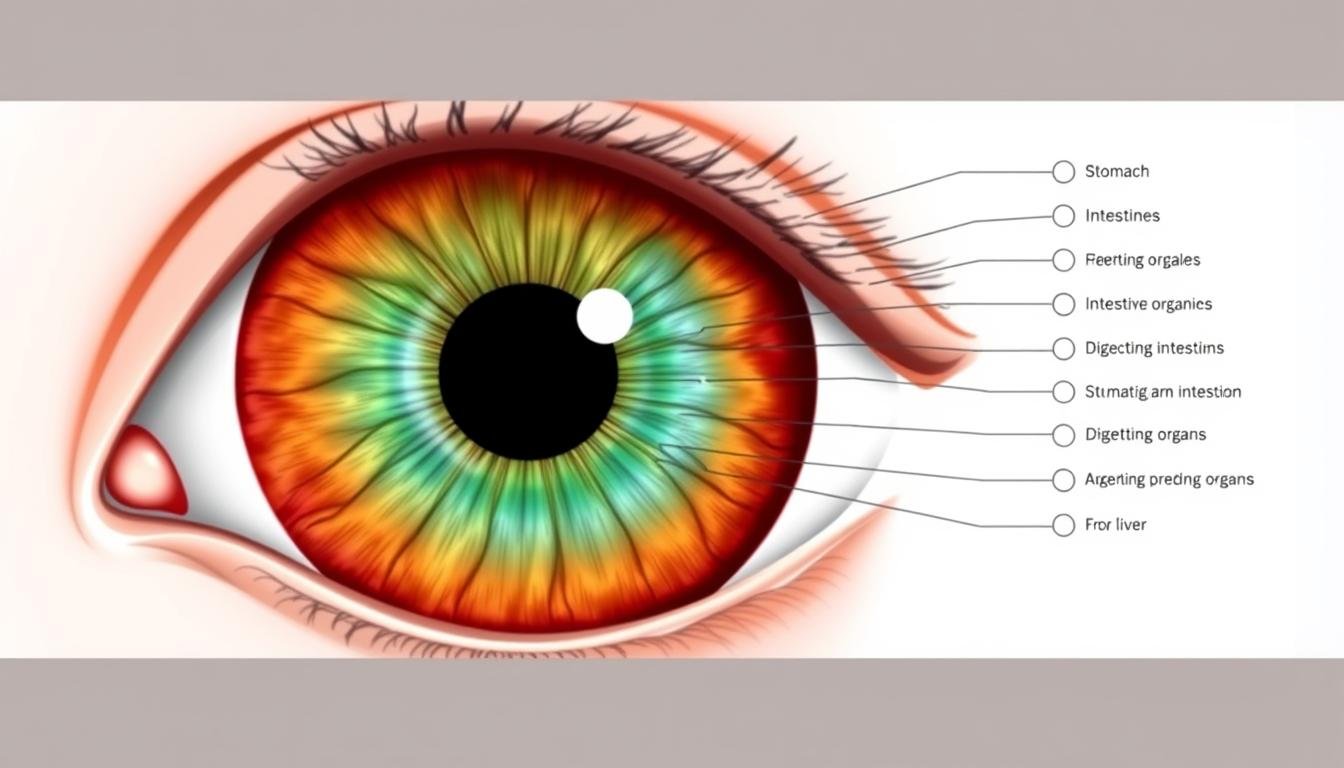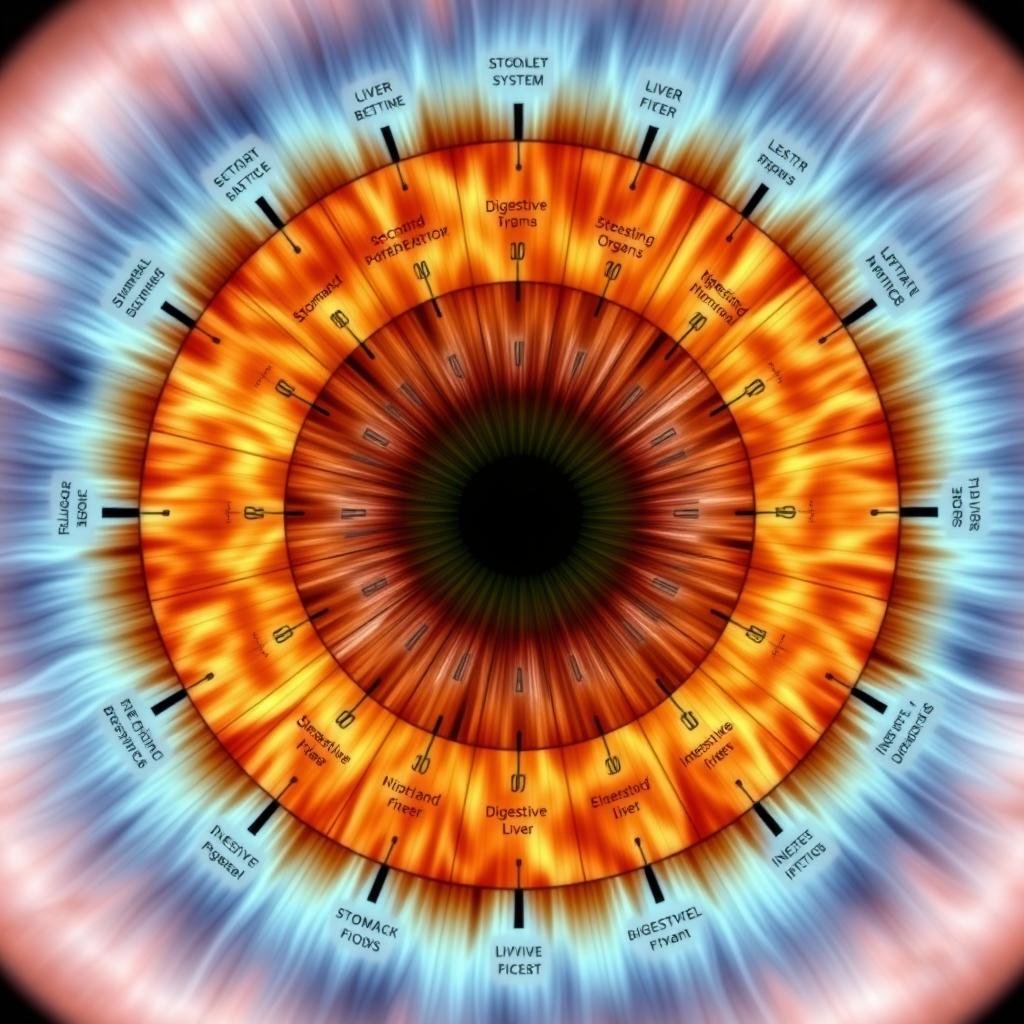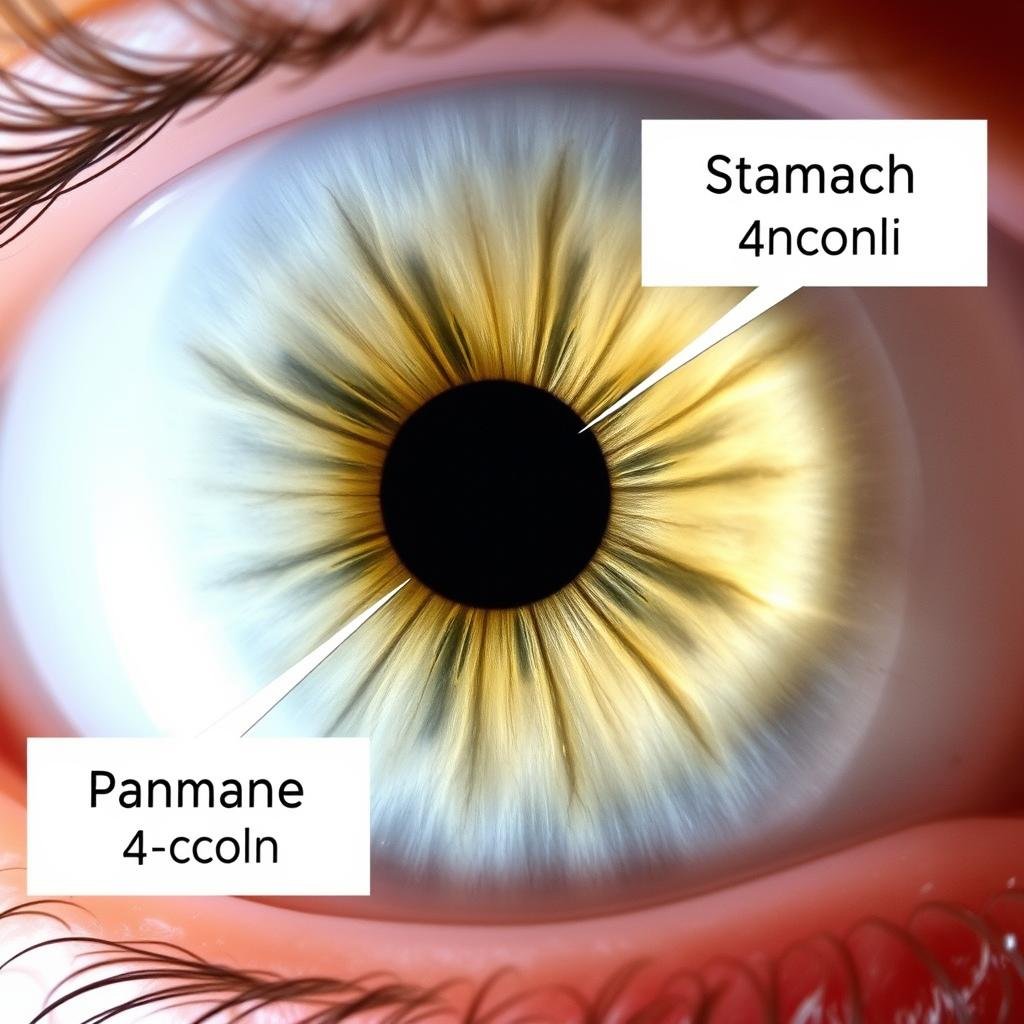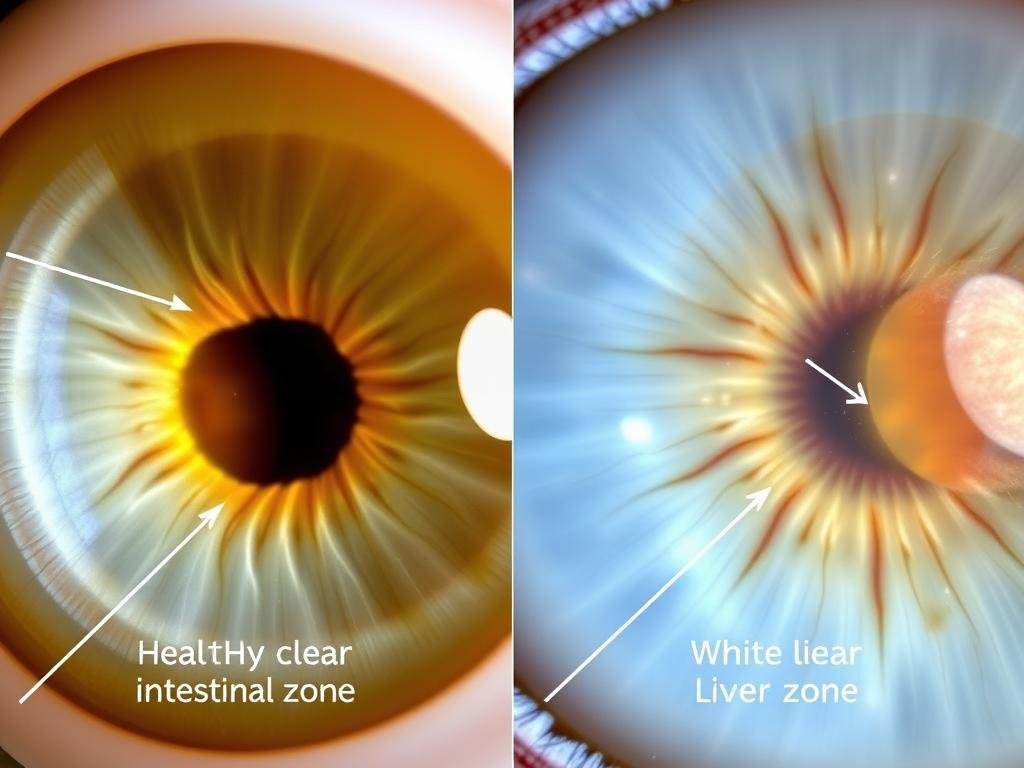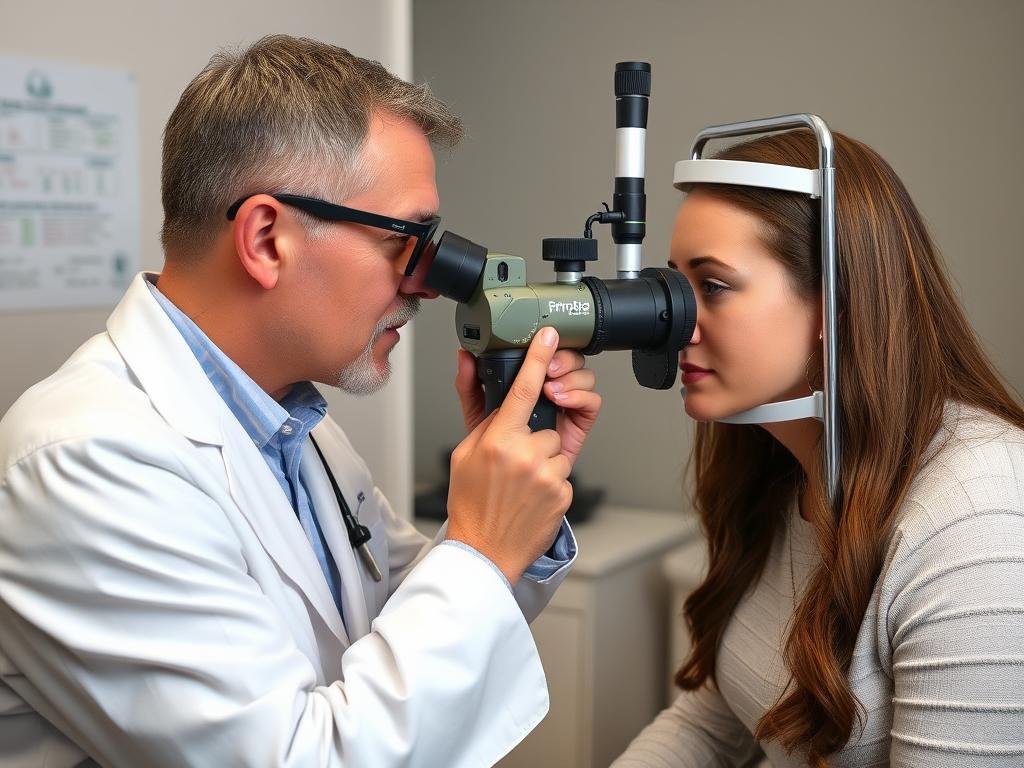Understanding the Иридологическая таблица
Ан иридологическая карта serves as a map that divides the iris into zones, each corresponding to different organs and systems within the body. These charts are the foundation of iridology practice, guiding practitioners in analyzing the patterns, colors, and markings in your iris to identify potential health concerns, particularly in the digestive system.

Basic iridology chart showing major organ correlations
Как Иридологическая таблица Mapping Works
Iridology mapping follows a specific methodology where the iris is divided like a clock face. In traditional iridology, the right iris corresponds to the right side of the body, while the left iris reflects the left side. The digestive system spans both irises, with specific zones dedicated to the stomach, intestines, liver, and other digestive organs.
Иридологическая таблица
| Положение часов | Left Eye (Reflects Left Side Body) | Right Eye (Reflects Right Side Body) |
|---|
| 1 О'КЛОК - 2 О'КЛОК | Left Neck: Reproductive organs (uterus/ovaries/testes) | Right Face: Reproductive organs (uterus/ovaries/testes) |
| 2 часа - 3 часа | Left Lung: Respiratory health | Right Throat: Health joints (knees, hips, elbows, shoulders) |
| 3 часа - 4 часа | Left Thorax: Spine health, flexibility, alignment | Right Upper Back: Spine health, flexibility, alignment |
| 4 часа - 5 часов | Left Upper Abdomen: Bladder, urinary system | Right Bladder: Reflects bladder and left side urinary system |
| 5 часов - 6 часов | Left Pelvic Area: Colon, small intestine, digestive health | Right Pelvic Area: Colon, small intestine, digestive health |
| 6 часов - 7 часов | Left Lower Abdomen: Right kidney (filtration, detox) | Right Lower Abdomen: Left kidney (filtration, detox) |
| 7 часов - 8 часов | Left Upper Abdomen: Stomach, digestive organs | Right Upper Abdomen: Stomach, digestive organs |
| 8 часов - 9 часов | Left Thorax: Liver, detoxification, bile production | Right Thorax: Liver, detoxification, bile production |
| 9 часов - 10 часов | Left Lung: Cardiovascular health, circulation | Right Lung: Cardiovascular health, circulation |
| 10 часов - 11 часов | Left Neck: Health joints (knees, hips, elbows) | Right Neck: Health joints (knees, hips, elbows) |
| 11 часов - 12 часов | Left Brain: Cognitive function, mental health | Right Brain: Cognitive function, mental health |
| 12 часов - 1 часа | Left Brain: Cognitive function, mental health | Right Brain: Cognitive function, mental health |
Key Zones in the Иридологическая таблица
The digestive system occupies significant portions of the iridology chart, reflecting its importance to overall health. The stomach zone typically appears in the left iris between 2 and 3 o’clock, while the liver zone is found in the right iris between 6 and 7 o’clock. The intestinal tract forms a ring around the pupil in both eyes, with the small intestine closer to the pupil and the large intestine in the outer ring.

Right iris showing liver and gallbladder zones

Left iris showing stomach and pancreas zones
Curious About What Your Iris Reveals?
General charts can only tell you so much. Discover what your unique iris patterns reveal about your digestive health with a personalized analysis.
Запланируйте консультацию
The Иридологическая таблица and Digestive System Connection
The digestive system is prominently represented in иридологические диаграммы, with distinct zones corresponding to each major digestive organ. This detailed mapping allows practitioners to identify potential imbalances in specific digestive functions by analyzing the corresponding iris areas.

Common iris markings and their digestive health correlations
Interpreting Gut Health Through Иридологическая таблица Узоры
Iridologists look for specific patterns, colors, and markings in the digestive zones of the iris to assess gut health. White spots may indicate inflammation, while dark spots might suggest toxin accumulation. Radial lines or “spokes” extending from the pupil through the intestinal zone could indicate irritation or spasms in the intestinal tract.
| Радужная оболочка | Появление | Potential Digestive Indication |
| White Clouds | Fluffy white areas | Mucus accumulation, potential food sensitivities |
| Темные пятна | Brown or black dots | Toxin accumulation, sluggish elimination |
| Radial Lines | Spoke-like lines from pupil | Intestinal irritation, potential spasms |
| Лакуны | Enclosed dark areas | Chronic weakness in specific organ |
| Yellow Tint | Overall yellowish hue | Liver or gallbladder stress |
Case Study: Иридологическая таблица Analysis for IBS
Irritable Bowel Syndrome (IBS) is one of the most common digestive disorders, affecting millions worldwide. In iridology, practitioners often observe specific patterns in the intestinal zone of patients with IBS symptoms. These typically include increased radial lines in the intestinal area, potential discoloration in the liver zone, and sometimes white markings indicating inflammation.

Comparison between healthy iris patterns and those commonly seen with IBS
“While conventional medicine focuses on managing IBS symptoms, iridology offers insights into potential underlying imbalances that may contribute to the condition. By addressing these foundational issues, many patients find improvement beyond symptom management.”
Dr. Elena Michaels, Integrative Health Practitioner
Struggling with Digestive Issues?
Your iris may hold clues to the root causes of your digestive discomfort. Our certified iridologists specialize in digestive health analysis.
Book Your Iris Analysis
2025 Updates to Иридологическая таблица Practices
The field of iridology has evolved significantly in recent years, with 2025 bringing notable advancements in both chart interpretation and technology. Modern иридологические диаграммы now incorporate findings from recent research, offering more nuanced insights into digestive health.

State-of-the-art digital iridology analysis system (2025)
Modern vs Traditional Иридологическая таблица Interpretations
While traditional iridology relied heavily on visual inspection and subjective interpretation, modern approaches incorporate digital imaging, standardized analysis protocols, and integration with other health assessments. This evolution has brought greater consistency and precision to the practice.
| Аспект | Traditional Iridology (Pre-2020) | Modern Iridology (2025) |
| Analysis Method | Visual inspection with magnifying tools | High-resolution digital imaging with AI analysis |
| Chart Complexity | Basic organ mapping | Detailed mapping including microbiome indicators |
| Интеграция | Standalone assessment | Integrated with other health metrics and biomarkers |
| Digestive Focus | General organ assessment | Specific digestive functions and microbiome balance |
| Scientific Approach | Largely empirical observations | Combination of traditional knowledge and clinical research |
Digital Иридологическая таблица Tools
The digital revolution has transformed iridology practice with sophisticated software that can capture, analyze, and track changes in the iris over time. These tools offer unprecedented precision in mapping the iris and correlating findings with digestive health indicators.

Modern iridology software with digestive system analysis capabilities
Advantages of Digital Iridology
- Higher precision through standardized analysis
- Ability to track subtle changes over time
- Enhanced detection of early digestive imbalances
- Reduced subjectivity in interpretation
- Integration with other health data for comprehensive assessment
Ограничения, которые следует учитывать
- Technology cannot replace practitioner expertise
- Digital tools may miss subtle nuances visible to trained eyes
- Overreliance on technology may reduce holistic assessment
- Varying quality among available software solutions
- Limited standardization across different systems
Using Your Иридологическая таблица for Prevention
One of the most valuable aspects of иридологические диаграммы is their potential for preventive health. By identifying potential digestive weaknesses before they manifest as symptoms, you can take proactive steps to support your digestive health and potentially prevent future issues.

Basic self-examination can help you become familiar with your iris patterns
3-Step Иридологическая таблица Self-Analysis
While professional analysis is always recommended for comprehensive assessment, you can perform a basic self-examination to become familiar with your iris patterns and potentially identify areas that may benefit from additional support.
Step 1: Observation
- Use a magnifying mirror in natural light
- Take clear photos of both irises with a smartphone
- Note the overall color and clarity of your iris
- Look for any obvious markings or discolorations
- Compare left and right iris patterns
Step 2: Reference
- Compare your observations with a basic iridology chart
- Focus on the digestive zones (intestinal ring, liver, stomach)
- Note any patterns in areas corresponding to digestive organs
- Research common iris signs related to digestive health
- Document your findings for future comparison
Step 3: Action
- Support areas showing potential weakness
- Implement dietary adjustments based on observations
- Track changes in both iris patterns and digestive symptoms
- Consult with a professional for validation
- Develop a personalized digestive support plan
When to Consult a Professional
While self-analysis can be informative, professional iridology assessment provides deeper insights and expert interpretation. Consider consulting a certified iridologist if you notice significant markings in digestive zones, experience persistent digestive symptoms, or want a comprehensive health assessment.

Professional iridology assessment provides expert interpretation and guidance
Important Note on Iridology Limitations
Iridology is best used as a complementary assessment tool, not as a replacement for conventional medical diagnosis. Always consult with healthcare providers for digestive symptoms, and use iridology insights as part of a comprehensive approach to health.
Ready for Expert Iris Analysis?
Our certified iridologists specialize in digestive health assessment and can provide personalized insights based on your unique iris patterns.
Request Your Consultation
Часто задаваемые вопросы о Иридологические диаграммы
Can an Iridology Chart detect specific digestive diseases?
Iridology charts cannot diagnose specific diseases. Rather, they indicate areas of potential weakness or stress in the body’s systems. For digestive health, iridology can reveal patterns suggesting inflammation, congestion, or functional imbalances in digestive organs, but these observations should be correlated with clinical symptoms and conventional testing for proper diagnosis.
How accurate are Iridology Charts for digestive assessment?
The accuracy of iridology charts for digestive assessment varies. While many practitioners report correlations between iris signs and digestive conditions, scientific validation remains limited. Iridology is most valuable when used as part of a comprehensive health assessment that includes medical history, symptoms, and conventional testing. Its strength lies in identifying potential constitutional weaknesses rather than providing definitive diagnoses.
Do iris patterns change as digestive health improves?
According to iridology principles, some iris markings represent acute conditions and may change over time, while others indicate constitutional patterns that remain relatively stable. Acute inflammation signs may diminish as digestive health improves, but structural markings typically remain. Modern digital iridology allows for tracking subtle changes that might correlate with improved digestive function.
How do 2025 iridology charts differ from traditional ones?
Modern 2025 iridology charts incorporate more detailed mapping of digestive zones, including microbiome indicators and functional relationships between organs. They often integrate findings from recent research and utilize digital analysis tools for greater precision. While maintaining the foundational principles of traditional charts, modern versions offer more nuanced interpretation and better integration with other health assessment methods.
Can children benefit from iridology chart analysis for digestive issues?
Iridology can be performed on children, and some practitioners specialize in pediatric iridology. For digestive issues, iridology may help identify constitutional tendencies that could influence digestive function. However, children’s irises continue developing until around age 6, so interpretations should consider this developmental aspect. As with adults, iridology for children should complement, not replace, conventional medical care for digestive concerns.
Embracing the Insights of Иридологические диаграммы for Digestive Wellness
Изучение иридологические диаграммы offers a unique perspective on digestive health, allowing us to visualize potential imbalances through the intricate patterns of the iris. While iridology should not replace conventional medical diagnosis, it can provide complementary insights that support a holistic approach to digestive wellness.
As we’ve explored throughout this article, the connection between iris patterns and digestive function has both traditional roots and modern applications. The 2025 advancements in digital analysis tools have brought new precision to this ancient practice, making it more accessible and potentially more valuable as part of an integrated health assessment.
Whether you’re curious about what your iris might reveal about your digestive health or seeking to address specific digestive concerns, consider exploring iridology as one component of your wellness journey. Remember that the true value of any health assessment lies in how it informs practical actions that support your body’s natural healing abilities.



